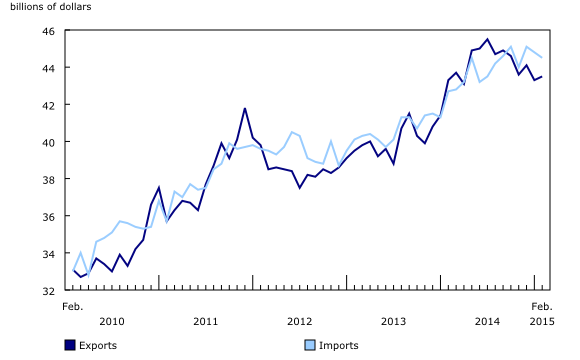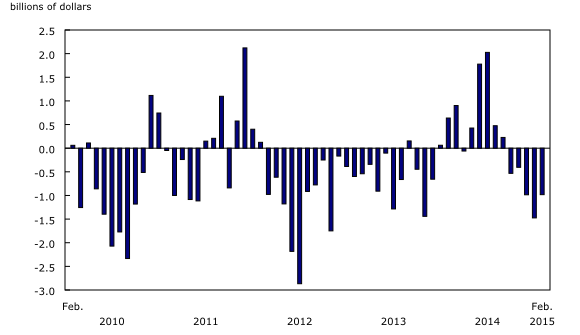Canadian international merchandise trade, February 2015
Archived Content
Information identified as archived is provided for reference, research or recordkeeping purposes. It is not subject to the Government of Canada Web Standards and has not been altered or updated since it was archived. Please "contact us" to request a format other than those available.
Released: 2015-04-02
Canada's imports declined 0.7% in February while exports were up 0.4%. Import volumes fell 1.7% while prices increased 1.1%. For exports, volumes were down 3.3% while prices rose 3.9%. Consequently, Canada's merchandise trade deficit with the world narrowed from $1.5 billion in January to $984 million in February.
January's trade deficit, originally reported as $2.5 billion in last month's release, was revised to $1.5 billion as estimates of energy products exports and special transactions trade imports were replaced with administrative and survey data as they became available.
Imports from the United States decline
Imports from the United States declined 1.2% to $29.8 billion in February. Imports from countries other than the United States edged up 0.3% to $14.7 billion, led by Mexico (+$81 million) and Saudi Arabia (+$59 million).
Exports to the United States rose 1.1% to $32.8 billion. Exports to countries other than the United States were down 1.5% to $10.8 billion, with the United Kingdom (-$555 million) and Japan (-$198 million) contributing the most to the decline.
As a result, Canada's trade surplus with the United States widened from $2.2 billion in January to $2.9 billion in February. Canada's trade deficit with countries other than the United States widened from $3.7 billion in January to $3.9 billion in February.
Imports decline on lower volumes
Imports were down to $44.5 billion in February, as 7 of 11 sections declined. Year over year, imports increased 4.3%.
Imports of motor vehicles and parts declined 4.7% to $7.5 billion. Passenger cars and light trucks (-5.4%) and motor vehicle engines and motor vehicle parts (-5.5%) contributed to the overall decrease in the section.
After reaching a record high in January, imports of industrial machinery, equipment and parts were down 4.3% to $4.5 billion in February. Other industry-specific machinery (-18.2%) and other general-purpose machinery and equipment (-4.0%) were the main contributors to the decline in the section. Overall, volumes were down 7.4% while prices were up 3.3%.
Energy products decreased 7.0% to $2.5 billion, the third consecutive monthly decline. Imports of crude oil and crude bitumen fell 19.7% to $1.1 billion, on lower volumes. Since November 2014, imports of crude oil and crude bitumen have declined 44.9%, with prices falling 27.0% and volumes 24.6%.
Imports of basic and industrial chemical, plastic and rubber products decreased 4.6% to $3.6 billion. Overall, prices declined 3.1% and volumes 1.5%. There were widespread declines in the section, led by lubricants and other petroleum refinery products, down 17.1% to $462 million.
Meanwhile, imports of metal ores and non-metallic minerals increased 16.3% to $918 million in February. Other metal ores and concentrates (+36.2%) were the main contributor to the increase. Overall, volumes increased 15.2%.
Energy products lead gain in exports
Exports rose to $43.5 billion in February, as 5 of 11 sections increased. Year over year, exports were up 0.5%.
Exports of energy products rose 14.9% to $8.8 billion. There were widespread increases in the section, led by crude oil and crude bitumen (+9.3%), natural gas (+45.1%) and refined petroleum energy products (+22.2%). Overall, prices increased 17.5% while volumes were down 2.3%.
Offsetting this increase, exports of motor vehicles and parts declined 15.1% to $5.9 billion. Lower exports of passenger cars and light trucks were the main contributor, down 24.1% to $3.7 billion, the lowest value since January 2014.
Note to readers
Merchandise trade is one component of Canada's international balance of payments (BOP), which also includes trade in services, investment income, current transfers as well as capital and financial flows.
International trade data by commodity are available on both a BOP and a customs basis. International trade data by country are available on a customs basis for all countries, and on a BOP basis for Canada's 27 principal trading partners (PTPs). The list of PTPs is based on their annual share of total merchandise trade—imports and exports—with Canada in 2012. BOP data are derived from customs data by making adjustments for factors such as valuation, coverage, timing and residency. These adjustments are made to conform to the concepts and definitions of the Canadian System of National Accounts.
For a BOP versus customs-based data conceptual analysis, see "Balance of Payments trade in goods at Statistics Canada: Expanding geographic detail to 27 principal trading partners."
Data in this release are on a BOP basis, seasonally adjusted and in current dollars. Constant dollars are calculated using the Laspeyres volume formula (2007=100).
For more information on seasonal adjustment, see Seasonally adjusted data – Frequently asked questions.
Revisions
In general, merchandise trade data are revised on an ongoing basis for each month of the current year. Current year revisions are reflected in both the customs and BOP based data.
The previous year's customs data are revised with the release of the January and February reference months as well as on a quarterly basis. The previous two years of customs based data are revised annually and are released in February with the December reference month.
The previous year's BOP based data are revised with the release of the January, February, March and April reference months. To remain consistent with the Canadian System of macroeconomic accounts, revisions to BOP based data for previous years are released annually in December with the October reference month.
Factors influencing revisions include late receipt of import and export documentation, incorrect information on customs forms, replacement of estimates produced for the energy section with actual figures, changes in classification of merchandise based on more current information, and changes to seasonal adjustment factors.
For more information on revisions for crude oil and natural gas, see "Revisions to trade data for crude oil and natural gas."
Revised data are available in the appropriate CANSIM tables.
Customs based data are now available in the Canadian International Merchandise Trade Database (Catalogue number65F0013X). From the Browse by key resource module of our website, choose Publications.
The February 2015 issue of Canadian International Merchandise Trade, Vol. 69, no. 2 (Catalogue number65-001-X), is also available from the Browse by key resource module of our website under Publications.
Data on Canadian international merchandise trade for March will be released on May 5.
Contact information
For more information, contact us (toll-free 1-800-263-1136; 514-283-8300; infostats@statcan.gc.ca).
To enquire about the concepts, methods or data quality of this release, contact Nita Boushey (613-404-4965), International Accounts and Trade Division.
- Date modified:



